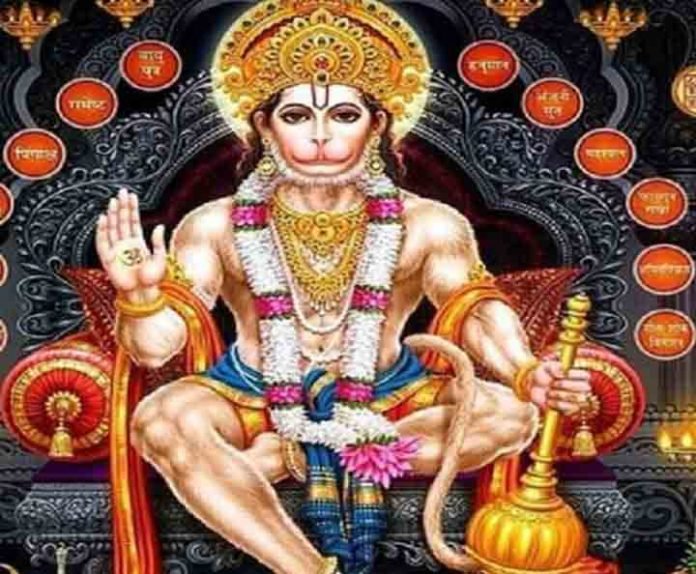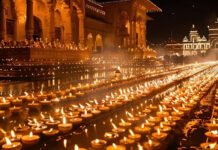When and Who Wrote the Hanuman Chalisa?
In Hinduism, each day of the week holds a special significance, dedicated to a specific deity. Tuesday (Mangalvar) is traditionally devoted to the worship of Lord Hanuman, the divine servant of Lord Shri Ram and the epitome of unwavering devotion, courage, and selfless service. On this day, devotees observe fasts, chant mantras, and read the Hanuman Chalisa to seek protection from sorrows, challenges, and evil forces.
The Hanuman Chalisa is not merely a prayer but a powerful hymn believed to carry immense spiritual potency. Reciting it is said to remove obstacles, attract blessings, and grant Akshaya Phal—eternal rewards. But how did this revered composition come into existence, who composed it, and what is the story behind it?
The Divine Connection Between Shri Ram and Hanuman
According to ancient scriptures, Lord Shri Ram and Lord Hanuman are inseparably linked. Hanuman is considered the ultimate devotee—the one who embodies service without expecting rewards. It is believed that wherever the Ram Katha (narration of Lord Ram’s life and deeds) is recited, Hanuman’s invisible presence is assured.
One such moment in history marked the birth of the Hanuman Chalisa.
The Encounter Between Tulsidas and Hanuman
During the Bhakti Movement in India, the great poet-saint Goswami Tulsidas was deeply devoted to Lord Ram. While narrating the Ram Katha one day, Tulsidas met a mysterious man whose aura and demeanor were extraordinary. Without delay, Tulsidas sensed that this was no ordinary human—it was an invisible divine force.
The mysterious figure revealed to Tulsidas a place where he could meet Lord Hanuman in person. Guided by this information, Tulsidas journeyed to that location. When he finally encountered Hanuman, he was overcome with overwhelming reverence and joy.
Hanuman’s Blessing and the Birth of Hanuman Chalisa
Tulsidas expressed his deep desire to have darshan (divine vision) of Lord Shri Ram. Hanuman, pleased with Tulsidas’ devotion, instructed him to go to Chitrakoot, assuring that Lord Ram would appear before him there. It was in this deep spiritual connection that Tulsidas, inspired and blessed by Hanuman, composed the Hanuman Chalisa—forty chaupais (quatrains) in Awadhi language glorifying the virtues, strength, and devotion of Hanuman.
It is believed that Tulsidas composed it while imprisoned in Delhi by Mughal ruler Akbar’s court, where he invoked Hanuman’s help through his verses. The Hanuman Chalisa is said to have been divinely inspired, carrying the power of devotion, protection, and liberation.
Meaning and Structure of the Hanuman Chalisa
The Hanuman Chalisa consists of:
Two introductory Dohas (couplets)
Forty Chaupais (quatrains)
One concluding Doha
Each verse praises Hanuman’s strength (bal), wisdom (buddhi), knowledge (vidya), and unmatched devotion to Lord Ram. The hymn narrates his divine birth, heroic deeds, and key roles in the Ramayana, such as:
Leaping across the ocean to Lanka
Delivering Lord Ram’s message to Sita in Ashok Vatika
Burning Lanka with his fiery tail
Bringing the Sanjeevani herb to save Lakshman
Assisting Sugreev and Vibhishan in their respective struggles
Historical Context and the Bhakti Movement
The Bhakti Movement (14th–17th century) emphasized personal devotion over ritualistic practices. Tulsidas emerged as a towering figure during this period, composing several works that made spiritual teachings accessible to the masses in local languages.
Through the Hanuman Chalisa, Tulsidas gave devotees a simple yet immensely powerful means of connecting with the divine. Its language is direct, its rhythm captivating, and its spiritual depth profound—making it easy for anyone, regardless of social or educational background, to recite and understand.
Mythological Significance of Reciting the Hanuman Chalisa
1. Protection from Negative Forces
It is believed that reciting the Hanuman Chalisa wards off evil spirits, black magic, and malevolent energies. The hymn specifically mentions how ghosts and demons flee when Hanuman’s name is chanted.
2. Healing and Health Benefits
Devotees believe that regular chanting can alleviate physical and mental ailments, bringing peace of mind and strength to overcome difficulties.
3. Removal of Obstacles
The Chalisa invokes Hanuman’s grace to make impossible tasks possible, removing hurdles in personal and professional life.
4. Blessings of Wisdom and Strength
By remembering Hanuman’s unparalleled qualities, devotees seek his blessings for courage, intellect, and determination.
Key Verses with Profound Impact
“Bhoot Pishach Nikat Nahi Aave, Mahaveer Jab Naam Sunave”
Evil spirits never dare approach when the mighty Hanuman’s name is heard.“Sankat Se Hanuman Chhudave, Man Kram Vachan Dyan Jo Lave”
Hanuman liberates those from troubles who meditate on him with mind, word, and deed.“Ashta Siddhi Nav Nidhi Ke Data, As Bar Din Janki Mata”
You are the giver of the eight spiritual powers and nine treasures, as blessed by Mother Sita.
Hanuman Chalisa in Daily Life
The Hanuman Chalisa is not confined to temples or religious gatherings. Many households recite it daily, especially on Tuesdays and Saturdays. Some follow the practice of reading it 100 times to fulfill a specific wish or to seek deliverance from a major crisis.
Devotees often begin their day by chanting the opening dohas, setting a spiritual tone for the day. In times of fear or uncertainty, reciting it even once is said to restore confidence and calmness.
The Enduring Legacy of Tulsidas and the Hanuman Chalisa
More than four centuries after its composition, the Hanuman Chalisa continues to be one of the most beloved and widely recited hymns in Hinduism. Its verses have been translated into numerous languages, sung in countless melodies, and passed down through generations.
For millions, it is more than poetry—it is a shield of faith, a source of inspiration, and a bridge to divine grace. The enduring power of this composition lies in its simplicity, emotional depth, and unwavering devotion that transcends time, culture, and geography.
Conclusion
The Hanuman Chalisa is not merely a literary masterpiece—it is a living, breathing expression of love and devotion toward Bajrangbali. Composed by Goswami Tulsidas during a spiritually rich period of India’s history, it stands as a testament to the eternal bond between Shri Ram and Hanuman.
By chanting it with faith and devotion, one taps into an ancient current of divine energy that has empowered devotees for centuries. As the verses proclaim, Hanuman’s blessings grant strength, wisdom, protection, and liberation—making the Hanuman Chalisa a timeless treasure of spiritual heritage.
















